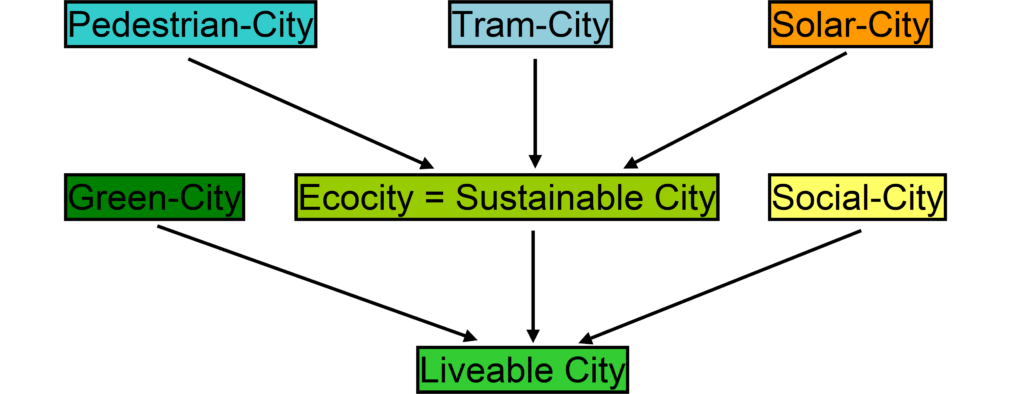The vision of sustainable and liveable settlements for the future
ECOURBAN Development is dealing with settlements ranging from large cities (ECOCITY) to small towns (ECOTOWN).
Challenges are differing for different sizes (e.g. increasing share of low density sprawl the smaller the settlement). But requirements and principles are to a large extent the same.
Context of ECOURBAN components

Pedestrian-City
Living and working in pedestrian-oriented quarters of short distances
Tram-City
Rail-oriented settlement structure with concentration around stops
Solar-City
Efficient utilisation of renewable energy sources (Solar etc.)
Ecocity
Solar-oriented buildings in pedestrian-oriented quarters in rail-oriented settlements (corridor development)
Green-City
Diverse public space with integrated green and water areas
Social-City
Solidarity, balanced age distribution and social structure, good life for all
Liveable-City
Wellbeing promoted by urban design for high quality of life (health, safety)
Requirement profile
ECOURBAN development needs to be
- sustainable, ecologic:
That all measures and activities are ecologic and sustainable is an absolute requirement to allow/enable/facilitate human life on earth in the long term. Future settlements must be in balance with nature. - space-saving, transport-saving, energy-saving:
To keep the built-up area of settlements as small as possible (by appropriate density) facilitates more green areas and especially short distances/trips with less motorised transport. This reduces the energy consumption in transport, while high insulation reduces the energy consumption of buildings, making both sustainable. - climate compatible:
The above savings also make an important contribution to meet the climate-goals. - social:
That all measures and activities are social is an important precondition for a decent civic life in a community. - liveable, healthy:
Lower pressures from harmful substances and noise promote the health of inhabitants and, together with a good social climate, the quality of life in settlements.
Sustainability
To be sustainable is crucial for settlement patterns, because they are the by far largest man-made objects consuming huge amounts of resources for their implementation and because of their long lifespan corrections require particularly great efforts.
Sustainable patterns should also allow future generations to organize their lives in these settlements at a high-quality level.
ECOURBAN Basic Principles
Design ecourban patterns appropriate for sustainable mobility for all, providing accessibility to all destinations by walking and public transport.
Design ecourban buildings for maximum comfort with minimum (renewable) energy input and using ecological materials.
Organise society and economy in ecourban settlements for a good life for all in decent communities as well as for sustainable regional production and consumption
Benefits of ECOURBAN development
Summary
ECOURBAN development provides a better quality of life for all inhabitants:
- reduced air and noise pollution and a lower risk of injury by traffic accidents
- more space for people in an attractive, quiet, safe and healthy environment
- shorter commutes to jobs or school, for shopping, recreation, to public transport stops, etc. due to proximity to most necessary facilities in mixed-use areas
ECOURBAN patterns privilege non-drivers (children, seniors and the handicapped)
ECOURBAN settlements mean
lower investment costs for infrastructure as well as lower operating and usage costs for heating and transportation
reduced land demand and sealed-up area due to compact dense urban patterns
Reduced emissions due to saving energy for transport services and buildings contribute to sustain the (natural) environment, the basis for human life.